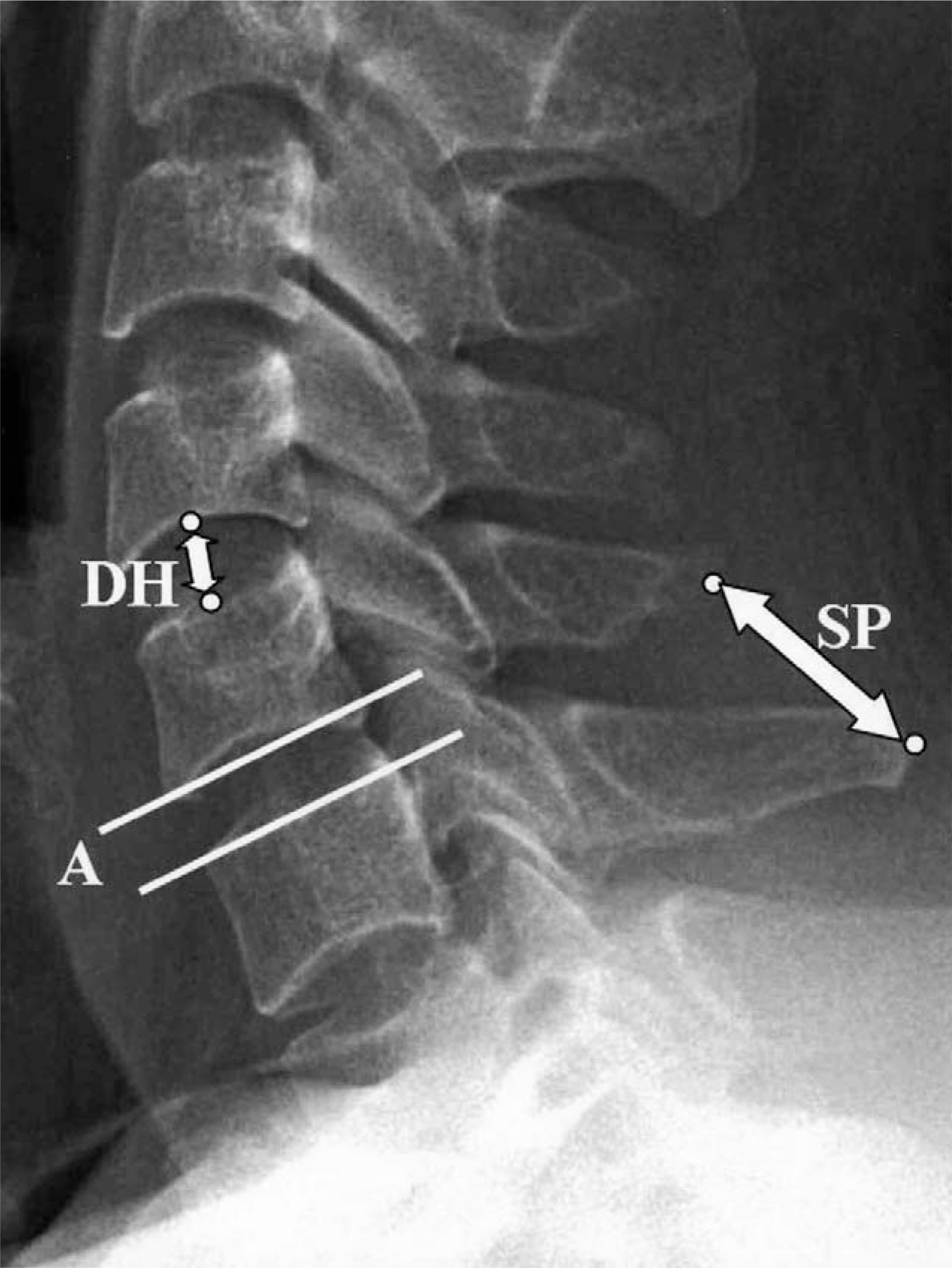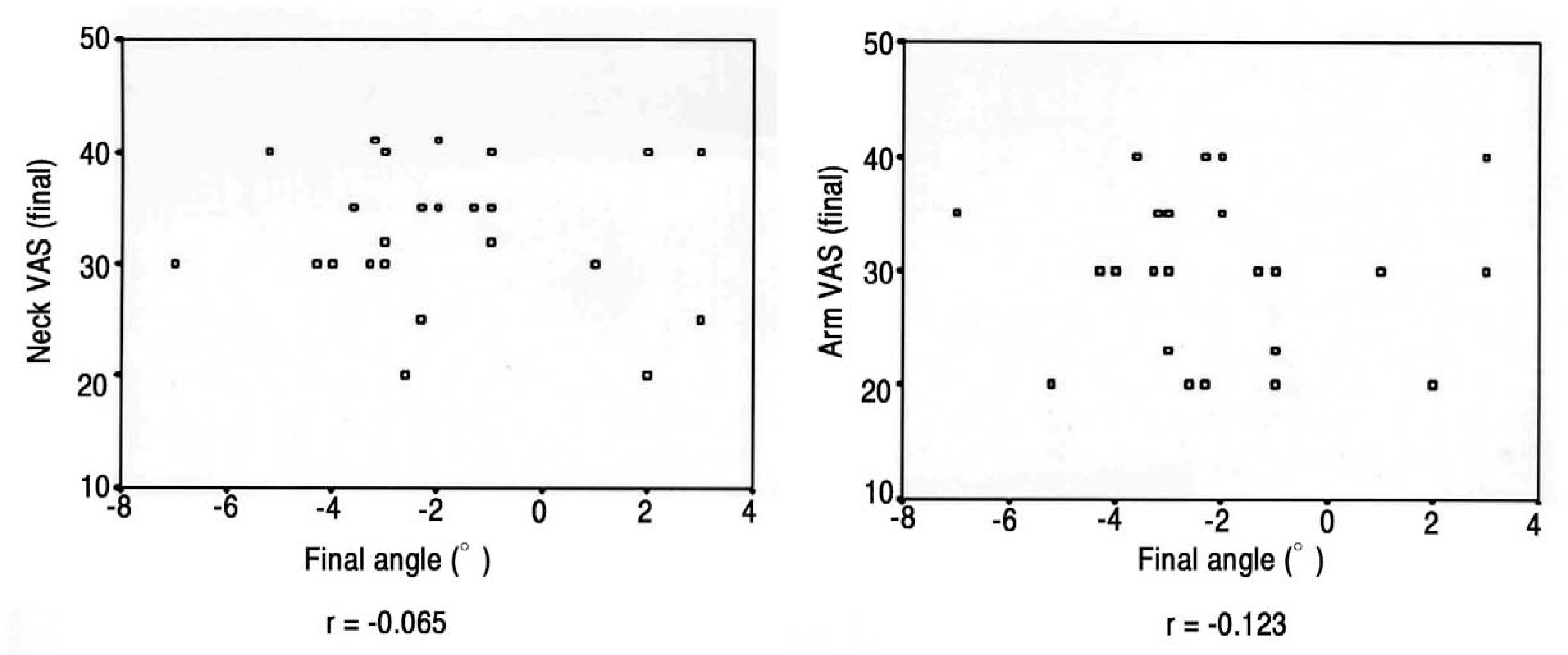J Korean Soc Spine Surg.
2006 Jun;13(2):81-86. 10.4184/jkss.2006.13.2.81.
The Correlation Between Radiographic and Clinical Results after Anterior Cervical Discectomy and Fusion
- Affiliations
-
- 1Department of Orthopaedic Surgery, College of Medicine, Chosun University, Gwangju, Korea. hmsohn@chosun.ac.kr
- 2Department of Occupational & Environmental Medicine, College of Medicine, Chosun University, Gwangju, Korea.
- KMID: 2097822
- DOI: http://doi.org/10.4184/jkss.2006.13.2.81
Abstract
-
STUDY DESIGN: This is a prospective study.
OBJECTIVES
We wanted to analyse the correlation between the radiographic and clinical results after anterior cervical discectomy and fusion (ACDF) for treating degenerative cervical diseases. Summary of Literature REVIEW: ACDF is a successful procedure for treating the degenerative cervical spine. Many studies have reported on radiographic results and clinical outcomes of this procedure. However, few studies have examined the relationships between the changes of the radiographic parameters and the clinical results after ACDF.
MATERIALS AND METHODS
26 patients who had single level ACDF performed for degenerative cervical diseases during the period between Jan, 2000 and Dec, 2004 were evaluated. All the patients underwent autologous iliac bone graft and plate fixation. The radiographic parameters, including the disc height, the disc space angulation and the spinous process distance were measured at the preoperative period, post operative 1 month and the last follow up period, respectively. The clinical changes were measured using the visual analogue scale (VAS) for neck and arm pain at the preoperative and last follow up period. The correlations between the radiographic parameters and the clinical outcomes were assessed by Pearson correlation.
RESULTS
There were significant changes in disc height (6.7-7.9 mm) as well as disc space angulation (kyphosis: 1.1degrees, lordosis: 3.4degrees). The reduction in the neck pain VAS score (63.9-33.1) and the arm pain VAS score (57.9-29.7) was significant. None of the correlations between the radiographic parameters and the clinical outcomes were significant (p>0.05).
CONCLUSION
Although the clinical outcomes improved significantly, there was no significant correlation between the radiographic parameters and clinical results after performing single level anterior cervical discectomy and fusion for the degenerative cervical disease.
Keyword
MeSH Terms
Figure
Reference
-
01). Smith GW., Robinson RA. The treatment of certain cervical spine disorders by anterior removal of the intervertebral disc and interbody fusion. J Bone Joint Surg. 1958. 40-A:607–624.02). Albert TJ., Smith MD., Bressler E., Johnson LJ. An in vivo analysis of the dimensional changes of the neurofora-men after anterior cervical diskectomy and fusion: a radi-ologic investigation. J Spinal Disord. 1997. 10:229–233.03). An HS., Evanich CJ., Nowicki BH., Haughton VM. Ideal thickness of Smith-Robinson graft for anterior cervical fusion. A cadaveric study with computed tomographic correlation. Spine. 1993. 18:2043–2047.04). Bayley JC., Yoo JU., Kruger DM., Schlegel J. The role of distraction in improving the space available for the cord in cervical spondylosis. Spine. 1995. 20:771–775.
Article05). Truumees E., Demetropoulos CK., Yang KH., Herkowitz HN. Effects of disc height and distractive forces on graft compression in an anterior cervical discectomy model. Spine. 2002. 27:2441–2445.
Article06). Olsewski JM., Garvey TA., Schendel MJ. Biomechanical analysis of facet and graft loading in a Smith-Robinson type cervical spine model. Spine. 1994. 19:2540–2544.
Article07). Truumees E., Demetropoulos CK., Yang KH., Herkowitz HN. Failure of human cervical endplates: a cadaveric experimental model. Spine. 2003. 28:2204–2208.
Article08). Jenis LG., An HS., Simpson JM. A prospective compari-son of the standard and reverse robinson cervical grafting techniques: radiographic and clinical analyses. J Spinal Disord. 2000. 13:369–373.
Article09). Kwon B., Kim DH., Marvin A., Jenis LG. Outcomes fol-lowing anterior cervical discectomy and fusion: the role of interbody disc height, angulation, and spinous process distance. J Spinal Disord Tech. 2005. 18:304–308.10). Spurling RG., Scoville WB. Lateral rupture of the cervical intervertebral discs. A common cause of shoulder and arm pain. Surg Gynecol Obstet. 1944. 78:350–358.11). Garvey TA., Transfeldt EE., Malcolm JR., Kos P. Out-come of anterior cervical discectomy and fusion as per-ceived by patients treated for dominant axial-mechanical cervical spine pain. Spine. 2002. 27:1887–1895.
Article12). Bohlman HH., Emery SE., Goodfellow DB., Jones PK. Robinson anterior cervical discectomy and arthrodesis for cervical radiculopathy. Long-term follow-up of one hun-dred and twenty-two patients. J Bone Joint Surg. 1993. 75:1298–1307.
Article13). Farmer J., Albert TJ., Balderston RA., Vaccaro A. Foraminal pressure changes during intervertebral distraction simulating anterior cervical discectomy. J Spinal Disord. 1998. 11:307–311.
Article14). Laing RJ., Ng I., Seeley HM., Hutchinson PJ. Prospective study of clinical and radiological outcome after anterior cervical discectomy. Br J Neurosurg. 2001. 15:319–323.15). Kozak JA., Hanson GW., Rose JR., Trettin DM., Tullos HS. Anterior discectomy, microscopic decompression, and fusion: a treatment for cervical spondylotic radiculopathy. J Spinal Disord. 1989. 2:43–46.
- Full Text Links
- Actions
-
Cited
- CITED
-
- Close
- Share
- Similar articles
-
- Anterior Cervical Discectomy
- Analysis of Noninstrumented Anterior Cervical Discectomy and Interbody Fusion in Degenerative Cervical Disease
- The Advantages of Rectangular Titanium Cage(RABEA) Fusion after Anterior Cervical Discectomy: Comparative Study of Fibula Allograft
- Acute Respiratory Distress Due to Delayed Hematoma after Anterior Cervical Discectomy Fusion
- Comparative Study of Clinical Outcomes of Anterior Cervical Discectomy and Fusion Using Autobone Graft or Cage with Bone Substitute




